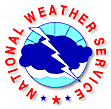| Forecasting the possibility of thunderstorm activity in your forecast area over the next 12 to 24 hours should begin with a detailed assessment of the current and forecast synoptic-scale weather pattern over the Pacific Northwest. Stability indices computed form 12Z soundings are useful tools in predicting the possibility of thunderstorm activity later in the day. However, an even better approach is to use stability indices computed from forecast soundings valid for late afternoon and evening hours. Pay close attention to calculated values of CAPE, 700-500 MB lapse rates, lifted index, K index, Showalter index, and the Total Totals index for signs of moist, unstable air. On the synoptic scale look for couplets of low level convergence and upper level divergence, mid-level triggers (short-waves or vorticity centers), theta-e ridges, frontal zone boundaries, jet streaks, etc. to determine the amount of atmospheric forcing.
Short-wave troughs or cold, upper level lows will oftentimes produce widespread thunderstorm activity across Western Washington. With this type of pattern, thunderstorms usually develop during the late afternoon and evening hours when surface heating destabilizes the air mass. However, this activity usually dissipates after sunset. The Puget Sound convergence zone is also a favored location for wet thunderstorms in May and June. With the various forcing mechanisms listed above an LAL of 3 or 4 would be appropriate since this type of thunderstorm activity is usually associated with locally moderate to heavy rain.
If the forecast models indicate an increasingly unstable air mass along with a synoptic pattern conducive to large-scale lift, forecast an LAL of 2 or 3, depending on the amount of ground strikes or rain expected. Use the LAL GUIDE on the fire weather homepage to determine the correct LAL. If the forecasted stability indices indicate very unstable air and moderate to heavy rainshowers are expected, consider forecasting an LAL of 4 or 5. Remember to check the moisture progs, i.e., precipitable water, to determine probability of moderate to heavy rainshowers. If the air mass below 700MB is expected to remain very dry (seldom the case in Western Washington ) and thunderstorms are expected, consider the possibility of dry lightning. If fuel and antecedent weather conditions have raised fire danger to high or extreme, consider issuing a Fire Weather Watch or a Red Flag Warning. Remember...if you issue a Red Flag Warning for dry lightning, you must forecast an LAL of 6.
|
|
|
|
|
|
 |
LIGHTNING PATTERN #1 - Close Upper Level Lows |
|
|
|
|
|
|
 |
LIGHTNING PATTERN #2 - Ejecting shortwaves |
|
|
|
|
|
|
 |
LIGHTNING PATTERN #3 - Subtropical Moisture |
|
|
|
|
|
|
 |
LIGHTNING PATTERN #4 - Shortwave in NW flow pattern |
|
|
|
 Critical Fire Weather Patterns
Critical Fire Weather Patterns

 Please refer any questions or comments about this web site to: john.werth@noaa.gov
Please refer any questions or comments about this web site to: john.werth@noaa.gov